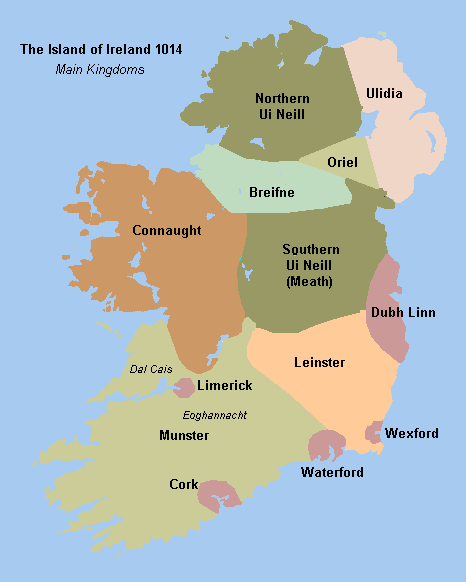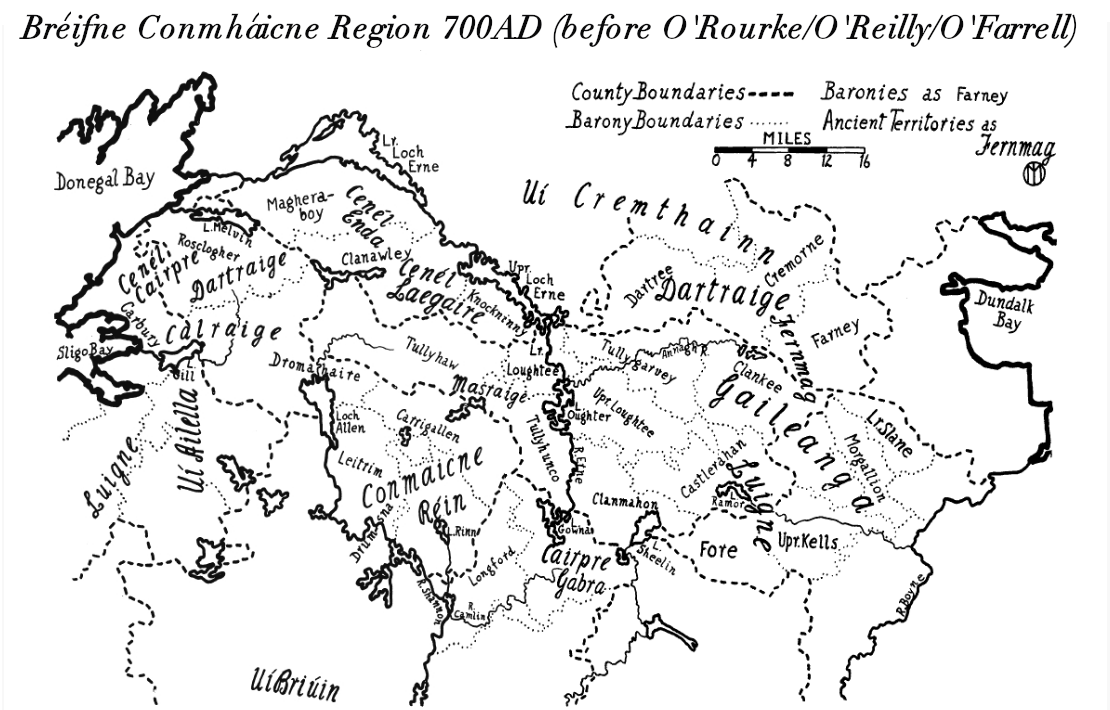|
Domnall Mac Ruaidrí Ua Conchobair
Domnall mac Ruaidrí Ua Conchobair (1102–1106) was King of Connacht. Domnall was the second son of Ruaidrí na Saide Buide to assume the kingship. He deposed Domnall mac Tigernáin Ua Ruairc, been assisted by aid of Muirchertach Ua Briain, who was his father Ruaidrí's brother-in-law. Domnall was the last Ua Ruairc of Breifne to become king of Connacht. Ua Briain, in 1106, had Domnall deposed by his younger brother, Toirdelbach Ua Conchobair, who was Muirchertach's nephew. Domnall's precise fate is unknown. Toirdelbach would in time go to great lengths to erase the descendants of his uncles and brothers from the genealogical record, leaving the succession open only to Ua Conchobair's descended from himself. References * ''West or H-Iar Connaught'' Ruaidhrí Ó Flaithbheartaigh, 1684 (published 1846, ed. James Hardiman James Hardiman (February 1782 – 13 November 1855), also known as Séamus Ó hArgadáin, was a librarian at Queen's College, Galway and an important h ... [...More Info...] [...Related Items...] OR: [Wikipedia] [Google] [Baidu] |
Connacht
Connacht or Connaught ( ; or ), is the smallest of the four provinces of Ireland, situated in the west of Ireland. Until the ninth century it consisted of several independent major Gaelic kingdoms (Uí Fiachrach, Uí Briúin, Uí Maine, Conmhaícne, and Delbhna). Between the reigns of Conchobar mac Taidg Mór (died 882) and his descendant, Aedh mac Ruaidri Ó Conchobair (reigned 1228–33), it became a kingdom under the rule of the Uí Briúin Aí dynasty, whose ruling sept adopted the surname Ua Conchobair. At its greatest extent, it incorporated the often independent Kingdom of Breifne, as well as vassalage from the lordships of western Mide and west Leinster. Two of its greatest kings, Tairrdelbach Ua Conchobair (1088–1156) and his son Ruaidri Ua Conchobair (c. 1115–1198) greatly expanded the kingdom's dominance, so much so that both became High King of Ireland. The Kingdom of Connacht collapsed in the 1230s because of civil war within the royal dynasty, which enab ... [...More Info...] [...Related Items...] OR: [Wikipedia] [Google] [Baidu] |
Ruaidrí Na Saide Buide
Rory is a given name of Gaelic origin. It is an anglicisation of the /''Ruaidhrí'' and /''Ruaraidh'' and is common to the Irish, Highland Scots and their diasporas. for the given name "Rory". The meaning of the name is "red king", composed of ''ruadh'' ("red") and ''rígh'' ("king"). In Ireland and Scotland, it is generally seen as a masculine name and therefore rarely given to females. History An early use of the name in antiquity is in reference to Rudraige mac Sithrigi, a High King of Ireland who eventually spawned the Ulaid (indeed, this tribe are sometimes known as ''Clanna Rudhraighe''). Ruadrí mac Domnall was the grandfather of famous Scottish king Macbeth and the eponymous founder of ''Clann Ruaidrí'' ( House of Moray). Throughout the Middle Ages, the name was in use by various kings, such as Ruaidrí mac Fáeláin, Ruaidrí na Saide Buide and Ruaidrí Ua Conchobair, the last High King of Ireland. As well as this, Ruairí Óg Ó Mórdha, the famous King of L ... [...More Info...] [...Related Items...] OR: [Wikipedia] [Google] [Baidu] |
Muirchertach Ua Briain
Muirchertach Ua Briain (anglicised as Murtaugh O'Brien; c. 1050 – c. 10 March 1119), son of Toirdelbach Ua Briain and great-grandson of Brian Boru, was King of Munster and later self-declared High King of Ireland. Background and early career Muirchertach Ua Briain was a son of Toirdelbach Ua Briain, the previous Dalcassian King of Munster and de facto High King of Ireland. As a descendant of Brian Boru, he was part of the powerful O'Brien dynasty who ruled Ireland at the time. His mother was Derbforgaill, daughter of Tadhg Mac Giolla Pádraig of Osraige, who also bore Muirchertach's brother Tadhg.Carrigan; ''History and Antiquities of the Diocese of Ossory'', vol. 1, pg 51. His early life is largely unknown. The Annals of Tigernach give his birth date as 1050. Afterwards, he is not mentioned in any of the annals of Ireland until the year 1075 when he was defeated by the Kingdom of Airgíalla in battle near modern Ardee in County Louth, taking heavy losses. This was part ... [...More Info...] [...Related Items...] OR: [Wikipedia] [Google] [Baidu] |
Breifne
The Kingdom of Breifne or Bréifne (), anglicized as Breffny, was a medieval overkingdom in Gaelic Ireland. It comprised what is now County Leitrim, County Cavan and parts of neighbouring counties, and corresponds roughly to the Roman Catholic Diocese of Kilmore. It had emerged by the 10th century, as a confederation of ' headed by an overking drawn from the Uí Briúin Bréifne. By the 11th century, Bréifne was ruled by the Ua Ruairc (O'Rourke) dynasty. The kingdom reached the height of its power in the 12th century, under Tigernán Ua Ruairc. During the latter part of his reign, Bréifne took part in campaigns against the Norman invasion of Ireland. His assassination by the Anglo-Normans in 1172 was followed by a succession dispute, and a conflict between the Ua Ruairc and Ua Raghallaigh (O'Reilly) dynasties. Following the Battle of Magh Slecht in 1256, Bréifne split into West Breifne (ruled by the Ua Ruairc) and East Breifne (ruled by the Ua Raghallaigh). Bréif ... [...More Info...] [...Related Items...] OR: [Wikipedia] [Google] [Baidu] |
Toirdelbach Ua Conchobair
Toirdhealbhach Mór Ua Conchobhair (old spelling: Tairrdelbach Mór Ua Conchobair; 1088 – 1156) anglicised Turlough Mór O'Conor, was Kings of Connacht, King of Connacht (1106–1156) and High King of Ireland (ca. 1120–1156). Family background and early life Toirdelbhach was born in the year 1088. He was the youngest son of Ruaidrí na Saide Buide (died 1118), and his mother was Mór, daughter of Toirdelbach Ua Briain (1009–14 July 1086). Therefore, through his mother, his great-great-grandfather was Brian Boru. His brothers were Niall (killed 1093), Tadc (killed 1097), Conchobar (murdered 1103), and Domnall, King of Connacht (deposed 1106). There was at least one sister, Dubhchobhlaigh Bean Ua hEaghra of Luighne Connacht (died 1131). Ruaidrí was married to four or more women. According to the Annals of Tigernach, Toirdelbach's mother died the year he was born, suggesting his birth may have been arduous. In 1092, King Ruaidrí was blinded by Flaithbertaigh Ua Flaithbertai ... [...More Info...] [...Related Items...] OR: [Wikipedia] [Google] [Baidu] |
Domnall Ua Ruairc
Domnall Ua Ruairc (died 1102) was King of Connacht. Not much is known of King Domnall but it is stated that he defeated and slew in battle the previous king Tadg Mac Ruaidrí Ua Conchobair. References * ''Leabhar na nGenealach'', Dublin, 2004–2005 * ''Annals of the Four Masters'', ed. John O'Donovan, Dublin, 1856 * '' Annals of Lough Ce'', ed. W.M. Hennessey, London, 1871. * ''Irish Kings and High Kings'', Francis John Byrne Francis John Byrne (1934 – 30 December 2017) was an Irish historian. Born in Shanghai where his father, a Dundalk man, captained a ship on the Yellow River, Byrne was evacuated with his mother to Australia on the outbreak of World War II. A ..., 3rd revised edition, Dublin: Four Courts Press, 2001. * "Ua Ruairc", in Seán Duffy (ed.), ''Medieval Ireland: An Encyclopedia''. Routledge. 2005. pp. 1102 deaths Kings of Connacht People from County Cavan People from County Leitrim 11th-century Irish monarchs Year of birth unknown {{ ... [...More Info...] [...Related Items...] OR: [Wikipedia] [Google] [Baidu] |
Kings Of Connacht
The Kings of Connacht were rulers of the ''cóiced'' (variously translated as portion, fifth, province) of Connacht, which lies west of the River Shannon, Ireland. However, the name only became applied to it in the early medieval era, being named after the Connachta. The old name for the province was Cóiced Ol nEchmacht (the fifth of the Ol nEchmacht). Ptolemy Claudius Ptolemy (; , ; ; – 160s/170s AD) was a Greco-Roman mathematician, astronomer, astrologer, geographer, and music theorist who wrote about a dozen scientific treatises, three of which were important to later Byzantine science, Byzant ...'s map of c. 150 AD does in fact list a people called the Nagnatae as living in the west of Ireland. Some are of the opinion that Ptolemy's Map of Ireland may be based on cartography carried out as much as five hundred years before his time. The Connachta were a group of dynasties who claimed descent from the three eldest sons of Eochaid Mugmedon: Brion, Ailill and F ... [...More Info...] [...Related Items...] OR: [Wikipedia] [Google] [Baidu] |


